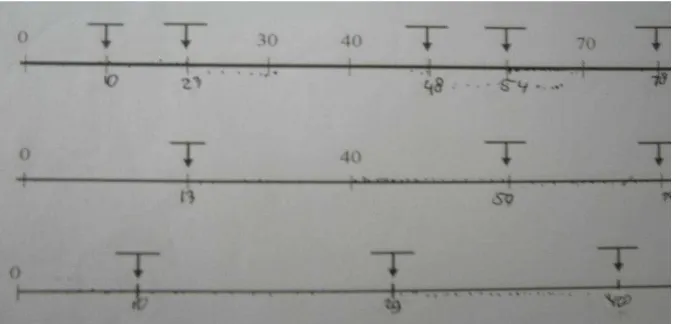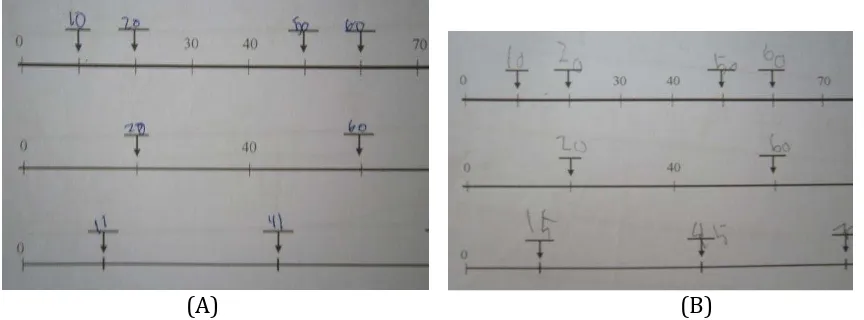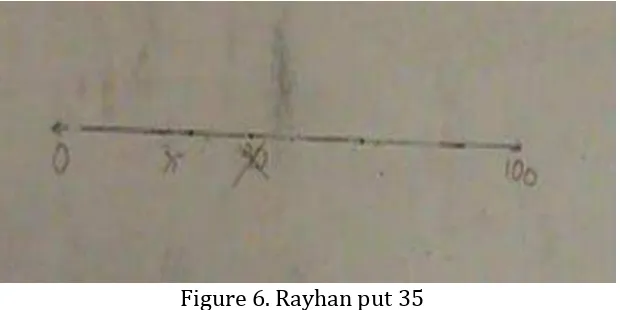399
INTRODUCING THE POSITION OF NUMBERS WITH NUMBER LINE
ACTIVITIES
Sakinah Nurul Fajri1, Ratu Ilma Indra Putri2, Yusuf Hartono3, Frans van Galen4 STKIP PGRI Padang1, Sriwijaya University2 , 3, Utrecht University4
sakinahfajri@yahoo.nl1, ratu.ilma@yahoo.com2,y.hartono@unsri.ac.id3,
f.vangalen@uu.nl4
Abstract
The paper describes the study to introduce the position of numbers to pupils in grade 2 in Indonesia (7-8 years old). We aim to make the pupils acquaint that the certain position on the closed number line represent a certain number. Design research was used as the approach for achieving this aim. A series of number line activities based on PMRI approach was used to encourage the pupils to consider the position of the number relative to other numbers. We used the closed number line, start with 0 and end with
, in this study. Guess my number game was also used to promote the idea of the
position of numbers.
Keywords : number position, number line, magnitude of numbers, design research, number sense
INTRODUCTION
Number sense can be defined as a holistic construct of mathematical relationships (Gersten, et al., 2005). One element of number sense is the relationship among numbers. Number relationships is specified as 1) contextualization: number relations in realistic context, 2) positioning: numbers and their relations to a corresponding position on the number line, 3) structuring: the relationship with other numbers (Van den Heuvel-Panhuizen, et al., 2001).
The development of number sense is linked to the development of an accurate mental model of the number line. The number line model can be used to develop the number sense. It provides pupils the visual representation of our number system. To be able to make sense of number line, pupils need to work with counting, comparing numbers and physical representations of number lines.
Based on finding from previous researches, there are three strategies that students use on positioning a number on an empty number line. They are the starting point strategy, the midpoint strategy and the endpoint strategy. In the starting point strategy, students star from the beginning of number line then count until the target number. Counting backwards happens in the endpoint strategy. In the middle point strategy, students start from the middle of the number line (Newman & Berger, 1984; Petito, 1990; Schneider et al., 2008; in Verkade, 2012). The most effective strategy is the midpoint strategy because it minimizes the errors students can make (Ashcraft & Moore, 2012).
400 numbers which is related to the development of number sense. We designed a number line game in which the pupils have to put the most appropriate card in the position that is marked.
Pupils will also play guess my number game. In this game, pupils will experience placing numbers on closed number line and ordering numbers. We also expected that after playing this game, pupils will be able to determine the position of benchmark numbers; 50, 75, 25.
The design is intended to make students able to locate a number on an empty number line. Realistic mathematics education (RME) approach was used in designing the activities. According to the design, teacher will guide students to use midpoint strategy on positioning a number. Moreover the students will be encouraged to explain their steps in locating numbers on the number line. Therefore we formulate research question: How can the number line activities promote pupils initial
understanding of the position of numbers?
Theoritical framework
Magnitude of numbers is one of the elements of number sense. Booth & Siegler (2008) state that positioning numbers on an empty number line includes the idea of estimating and judging the magnitude of numbers. The certain position gives each number a unique point on the line and a distance from zero depicting its magnitude and direction (NYSED, 2012). Our conclusion is using number line is useful to help the pupils to understand the magnitude of numbers.
In Indonesian curriculum, number magnitude is given in the early grades. The instructions usually focus on one part of number magnitude; ordering numbers. Number magnitude is introduced by using a structured number line. Pupils have to remember the magnitudes facts, such as 32 is smaller than 33 because 32 located on the left side of 33 (Fajariyah & Triratnawi, 2008) without understanding why they put it on the left or on the right.
The focus of this study is to see how pupils understanding of number magnitude can be supported by using an empty number line. The instructions are designed based on the major characteristics of Realistic Mathematics Education (RME) (Treffers, 1987).
Use of contextual problems
Contextual problems can be used as a starting point to make mathematics meaningful to children. In this design, the context that will be used is the mathematics itself.
Use of models
The number line is a useful model for doing estimation, multiplication, number representation, calculation, and it provides geometric models for the operations of arithmetic (Gravemeijer & Stephan, 2002; Skoumpourdi; Van den Heuvel-Panhuizen 2001). The model that is used in this study is the closed number line which starts with 0 and end with 100.
Use of pupils contribution
Pupils initial ideas and strategy are meaningful for them. The initial strategy need to be developed to a more advanced strategy. The development cannot be done if the pupils do not contribute their ideas. The activities in this study are designed to encourage pupils to give contributions based on their own ability.
401 The learning of mathematics is a social process (Van den Heuvel-Panhuizen 2001). The pupils are expected to share and discuss their strategy with other pupils. The pupils are given a group activity in which they can share and reflect their ideas. The classroom discussion is planned to be the place where pupils can express their opinion.
Intertwining
The idea of the position of number relates to the concept of the magnitude of numbers. Pupils will develop their understanding of the order of numbers and nurture their number sense. Pupils will also familiar with number line which is a useful model to be used in other mathematics topic.
Methods
This study aims at developing classroom activities that support pupils understanding of the position of number in the close number line. Design research is used to achieve the goal and to answer the research question. This study was carried out in class 2D SD Yayasan IBA. Twenty one pupils and one classroom teacher were involved in this study. Video recording and pupils written work will be investigated to see the learning process of pupils.
MAIN SECTION
To begin, pupils worked on a worksheet consists of two problems. In the first problem, there are three structured number line and the pupils have to determine the numbers that should be on the marks. From the second problem, pupils are expected to judge whether the numbers are placed on the correct position or not.
We expected the idea of the position of numbers will emerge from the third number line on the first problem. Pupils react differently to the first problem according to their level of thinking.
Figure 1. Asti answer to the first problem
From the written work above (Figure 1), we can see that the pupil used counting strategy to solve the problem. She did not consider the position of numbers; she put 23 and 13 on the same place. The pupil had not seen the closed number line as a physical representations of number system.
402 continued using counting by ten on the second number line. He did not use the number line fact, the position of 0, 40, 100, to answer the problem.
Figure 2. Aji answer to the first problem
The idea to use the position of number that already known to determine the numbers that are asked emerged in some of pupils work. The written works show how pupils react differently to these problems.
(A) (B)
Figure . Pupils answer to the first problem
The third number line could encourage the pupils to use the number on the two number lines above to determine what numbers are asked. In Figure 3A, pupil thought that the number is after the previous marks. Therefore she wrote 11 between 10 and 20 and 41 between 40 and 50. Figure 3B shows that this pupils realize the marks are not only after 10 or after 40. He might also think that the marks are between two numbers. Therefore he answer 15 and 45 to the problems.
The second problems (Figure 4) asked the pupils are asked whether the numbers are placed on the correct position or not.
Figure 4. The second problem
403 Teacher : Alsa, please read the last question?
Alsa : Does 65 placed on the position?
Teacher : Who can answer this question? I have not heard the opinion of this side. Silva, what do you think?
Silva : It is wrong.
Teacher : Silva said the position is wrong. Why do you think so, Silva? Silva : Mmm (shaking her head)
Teacher : Who can help Silva?
Darrel : Because... because it should be after... after... it should be after 50 Teacher : Any other opinion?
Margo : It is wrong. Because 65 is on the position of... mmm Teacher : Difkha, listen to your friend.
Margo : Because 65 is on the position of 90.
Teacher : Margo said it is wrong because 65 is on the position of 90. So where is the position of 65?
Margo : After 50.
Teacher : Margo said it should be 90 not 65 on that place. Do you agree with Margo? Pupil : Yes
Fragment . Pupils discuss the second problem
Classroom discussion was a placed where pupils can share their idea about the position of numbers. One pupils thought that 65 should be closer to 50. Another thought that 65 on that line was placed on the place of 90. The second problem could promote the idea of the position of numbers in classroom discussion.
After discussing the worksheet, pupils were asked to work in groups. The group task was to determine what numbers are asked on the number line. Each group was given a number line (Figure 5) with some questions (marks with arrows):
Figure 5. The group work problem
They were also given some number cards: 15, 28, 39, 60, 88, 98, 50, 75, 5, 99. They should put a card on each question. One group is discussing what number they should put on the last question mark (Fragment 2).
Teacher : Look, the number line ends with 100. You have 0 in the beginning.
(Darrel wants to put 98 but Asti does not agree. Asti counting backward from the end of the number line)
Asti : It is 90.
Darrel : We don t have . We have . Hey, put here. Difkha : What number is it on this card?
404 Darrel : But what about 98? (Darrel still thinks of 98)
Fragment . Pupils discuss what number should they put
After counting backward, Asti believed that the number should not be 98. She got 90 as her counting result. However, the was no card with 90 written on it. Darrel then proposed 88. It is not clear how Darrel came up with the idea to put 88. It is possible that he thought 88 is close to 90; therefore he concluded 88 is acceptable.
To solve the group work, all of the groups started to consider the position of numbers. Almost all of the pupils agree that they could not put 98 or 99 on the last question.
Teacher : So three groups answer 88 for the last problem. The other two answer 98. Now I want you to give your explanation why do you think it is 88 not 98.
Difkha : Because 98 is close to 100.
Teacher : Difkha said 98 is close to 100. So it should be 88. What about Zaky s group? Why did you answer 88?
(long silent from Zaki s group)
Teacher : Also for Naila s group. Please give your explanation. (silent from both groups)
Teacher : Do not hesitate to say your opinion. Why do you think it is not 98? Rafi, can you explain?
R : 98 is close to 100. However in the line, the question is not really close to 100 so we think it is not 98 but 88.
Teacher : Good explanation Rafi.
Fragment 3. Classroom discussion about the position of 88
Their argument (Fragment 3) shows that they considered the position of 98 and 99 on the number line. Pupils considered not only the correct order of numbers but also the position of numbers.
In the next meeting, teacher conduct guess my number game. Teacher had a hidden number and pupils had to guess what number is hidden. A closed number line was used as a tool to guess the number. Teacher stated that the hidden number is between 0 and 100. Everytime pupils tried to guess the number, the number that was mentioned is marked on the number line. When Rayhan was given a chance to guess, he asked whether the number is 35. Teacher asked him to put 35 on the number line.
Figure 6. Rayhan put 35
405
Fragment 4. Classroom discussion about the position of 35
Fragment shows that playing guess my number game could help the pupils to reason about the position of numbers. They started to think of the relative position of a number to another number.
CONCLUSION
The number line activities that were design can be used to promote the idea of the position of numbers. Pupils experienced ordering the numbers on the number line, not only in the correct order but also in the correct position. Teacher may use these activities to introduce the concept of the position of number on a closed number line to pupils.
The conclusion is limited to certain situation. This design worked in the classroom situation in which the pupils are free and active in stating their opinion. The classroom discussion is the main part of this discussion, because during discussion pupils can share their different opinion or reasoning about the position of numbers. This design also connected to teacher s role in classroom discussion. Teacher needs to be proactive and patience in encouraging pupils to give opinion. Teacher also has to be able to propose questions that can promote discussion.
REFERENCES
Booth, J. L., & Siegler, R. S. (2008). Numerical magnitude representations influence arithmetic learning. Child Development, 79, 1016-1031.
Gelman, R., & Gellistel, C. R. (1978). The child s understanding of number. US: Harvard
University Press.
Gersten, R., Jordan, N. C., & Flojo, J. R. (2005). Early identification and interventions for students with mathematics difficulties. Journal of Learning Disabilities, 38(4), 293-304
Kalchman, M., Moss, J., & Case, R. (2001). Psychological models for the development of mathematical understanding: Rational numbers and functions. In S. Carver & D. Klahr (Eds.), Cognition and Instruction (pp.1–38). Mahwah, NJ: Lawrence Erlbaum Associates.
Laski, E. V., & Siegler, R. S. (2007). Is 27 a big number? Correlational and causal connections among numerical categorization, number line estimation, and numerical magnitude comparison. Child Development, 78, 1723-1743.
McDonald, S.A. Number line estimation: the use of number line magnitude estimation to detect the presence of math disability in postsecondary students. Liberty University.
Van den Hauvel-Panhuizen and Tal Team. (2001). Children Learn Mathematics. The Netherlands : Freudenthal Institute Utrecht University.
This paper can be cited as Zulkardi(2013). Proceeding The First South East Asia Design/Development Research (SEA-DR) International



